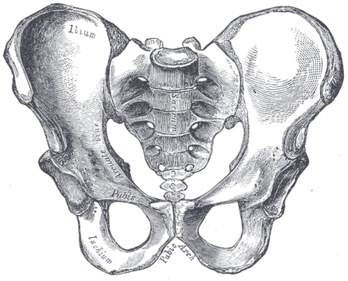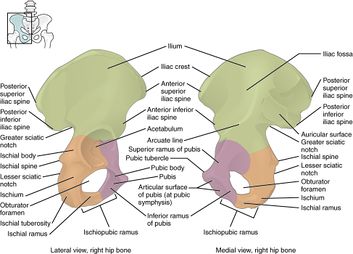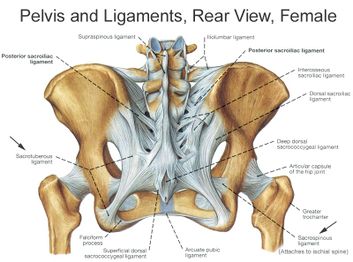Pelvis
Description[edit | edit source]
The pelvis consists of the sacrum, the coccyx,the ischium, the ilium, and the pubis. [1][2] The structure of the pelvis supports the contents of the abdomen while also helping to transfer the weight from the spine to the lower limbs.[3] During gait, the joints within the pelvis work together to decrease the amount of force transferred from the ground and lower extremities to the spine and upper extremities.[3]
Anatomy[edit | edit source]
Osteology[edit | edit source]
- sacrum
- coccyx
- two innominate bones, which consist of the:
- ischium
- ilium
- pubis[1]
Joint Articulations[edit | edit source]
There are three articulations within the pelvis:
- inferiorly between the sacrum and the coccyx
- posteriorly between the sacrum and each ilium (sacroiliac (SI) joint)
- anteriorly between the pubic bodies (pubic symphysis).[2]
Other articulations:
- the pelvis and femur articulate via the acetabulum[1]
Ligaments[edit | edit source]
Ligaments of the Pelvis[edit | edit source]
- Iliolumbar ligament
- Lateral lumbosacral ligament
- Sacrotuberous ligament
- Sacrospinous ligament
Muscles[edit | edit source]
There are 35 muscles that attach to the sacrum or innominates. The purpose of these muscles is primarily to provide stability to the joint not to produce movement.[4]
Muscles that attach to the sacrum or innominates are:
- Adductor brevis
- Adductor longus
- Adductor magnus
- Biceps femoris - long head
- Coccygeus
- Erector spinae
- External oblique
- Gluteus maxiumus
- Gluteus medius
- Gluteus minimus
- Gracilis
- Iliacus
- Inferior gemellus
- Internal oblique
- Latissimus dorsi
- Levator ani
- Multifidus
- Obturator internus
- Obturator externus
- Pectineus
- Piriformis
- Psoas minor
- Pyramidalis
- Quadratus femoris
- Quadratus lumborum
- Rectus abdominis
- Rectus femoris
- Sartorius
- Semimembranosus
- Semitendonosus
- Sphincter urethrae
- Superficial transverse perineal ischiocavernous
- Superior gemellus
- Tensor fascia lata
- Transversus abdominus
Sex-specific differences[edit | edit source]
Clinical Examination[edit | edit source]
Assessment[edit | edit source]
- Prior to the assessment of the sacroiliac joint both the lumbar spine and hip should be assessed and any underlying pathologist should be ruled out.
Special Tests[edit | edit source]
SI Joint Stress tests[edit | edit source]
- Anterior Gapping test
- Sacroiliac Distraction test
- Pubic Stress test
- Sacrotuberous Ligament Stress test
- Sacral Compression test
- Rotational Stress test
Leg Length tests[edit | edit source]
- Prone test
- Standing leg length test
- Functional leg length test
Other Special Tests[edit | edit source]
- Seated Flexion test (Piedallu's Sign)
- Long Sit test
- Sign of the Buttock
- Posterior Pelvic Pain Provocation test
- Gaenslen's test
- Yeoman's test
- FABER (Figure-Four) test
- Fortin Finger Test
- Straight Leg Raise - 70-90deg
- Gillet's test (Ipsilateral posterior rotation test)
Outcome Measures[edit | edit source]
Pathology/Injury[edit | edit source]
- Pubic Symphysis Dysfunction
- Spondyloarthropathies
- Pregnancy Related Pelvic Pain
- Pelvic Fractures
- Sacroiliitis
Physiotherapeutic Techniques[edit | edit source]
Resources[edit | edit source]
- ↑ 1.0 1.1 1.2 White, TD., Black, MT., Folkens, PA. Human osteology. Academic press; 2011.
- ↑ 2.0 2.1 Lewis CL, Laudicina NM, Khuu A, Loverro KL. The human pelvis: Variation in structure and function during gait. The Anatomical Record. 2017 Apr;300(4):633-42.
- ↑ 3.0 3.1 Magee DJ. Orthopedic physical assessment. Elsevier Health Sciences; 2013 Dec 4.
- ↑ Calvillo O., Skaribas I., Turnispeed J., Anatomy and pathophysiology of the SIJ, current science, 2000 (LOE 2A)









